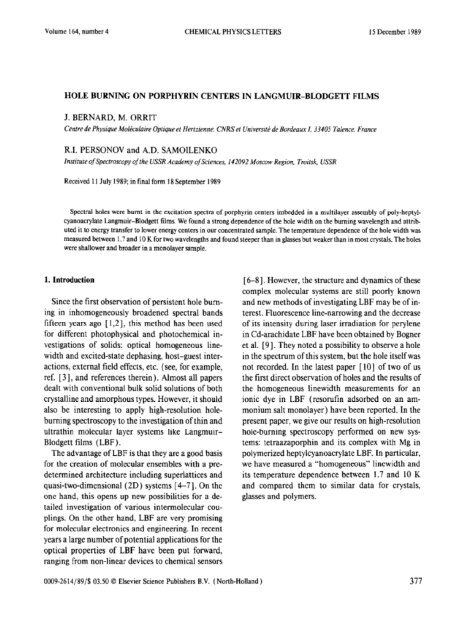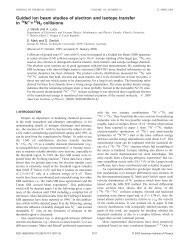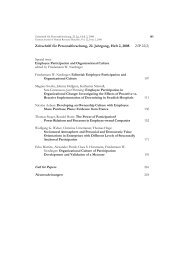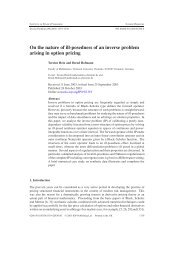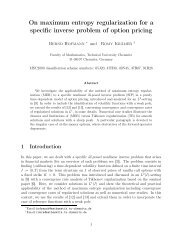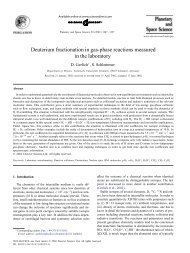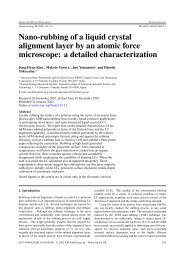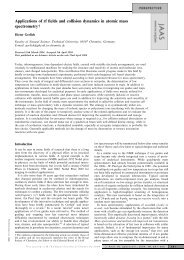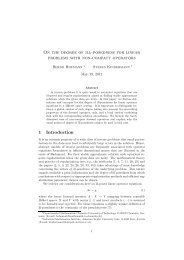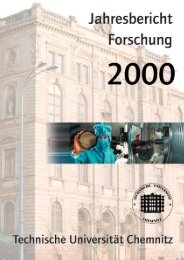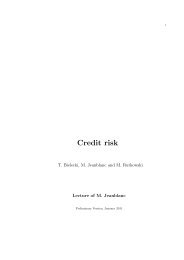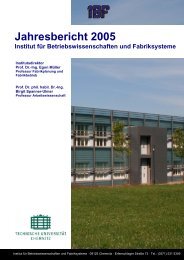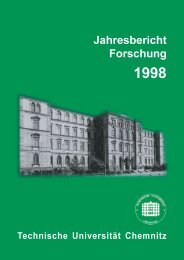HOLE BURNING ON PORPHYRIN CENTERS IN LANGMUIR ...
HOLE BURNING ON PORPHYRIN CENTERS IN LANGMUIR ...
HOLE BURNING ON PORPHYRIN CENTERS IN LANGMUIR ...
You also want an ePaper? Increase the reach of your titles
YUMPU automatically turns print PDFs into web optimized ePapers that Google loves.
Volume 164, number 4 CHEMICAL PHYSICS LETTERS 15 December 1989<br />
<strong>HOLE</strong> <strong>BURN<strong>IN</strong>G</strong> <strong>ON</strong> <strong>PORPHYR<strong>IN</strong></strong> <strong>CENTERS</strong> <strong>IN</strong> <strong>LANGMUIR</strong>-BLODGETT FILMS<br />
J. BERNARD, M. ORRIT<br />
Centre de Physique MolPcuiaire Optique et Hertzienne. CNRS el UniversG de Bordeaux I, 33405 Talence, France<br />
R.I. PERS<strong>ON</strong>OV and A.D. SAMOILENKO<br />
Institute of Spectroscopy of the USSR Academy ofsciences, I42092 Moscow Region, Troitsk, USSR<br />
Received 11 July 1989; in final form 18 September 1989<br />
Spectral holes were burnt in the excitation spectra of porphyrin centers imbedded in a multilayer assembly of poly-heptylcyanoacrylate<br />
Langmuir-Blodgett films. We found a strong dependence of the hole width on the burning wavelength and attributed<br />
it to energy transfer to lower energy centers in our concentrated sample. The temperature dependence of the hole width was<br />
measured between 1.7 and 10 K for two wavelengths and found steeper than in glasses but weaker than in most crystals. The holes<br />
were shallower and broader in a monolayer sample.<br />
1. Introduction<br />
Since the first observation of persistent hole burn-<br />
ing in inhomogeneously broadened spectral bands<br />
fifteen years ago [ 1,2], this method has been used<br />
for different photophysical and photochemical in-<br />
vestigations of solids: optical homogeneous line-<br />
width and excited-state dephasing, host-guest inter-<br />
actions, external field effects, etc. (see, for example,<br />
ref. [ 31, and references therein). Almost all papers<br />
dealt with conventional bulk solid solutions of both<br />
crystalline and amorphous types. However, it should<br />
also be interesting to apply high-resolution hole-<br />
burning spectroscopy to the investigation of thin and<br />
ultrathin molecular layer systems like Langmuir-<br />
Blodgett films (LBF).<br />
The advantage of LBF is that they are a good basis<br />
for the creation of molecular ensembles with a pre-<br />
determined architecture including superlattices and<br />
quasi-two-dimensional (2D ) systems [ 4-7 1. On the<br />
one hand, this opens up new possibilities for a de-<br />
tailed investigation of various intermolecular cou-<br />
plings. On the other hand, LBF are very promising<br />
for molecular electronics and engineering. In recent<br />
years a large number of potential applications for the<br />
optical properties of LBF have been put forward,<br />
ranging from non-linear devices to chemical sensors<br />
[ 6-81. However, the structure and dynamics of these<br />
complex molecular systems are still poorly known<br />
and new methods of investigating LBF may be of in-<br />
terest. Fluorescence line-narrowing and the decrease<br />
of its intensity during laser irradiation for perylene<br />
in Cd-arachidate LBF have been obtained by Bogner<br />
et al. [ 9 1. They noted a possibility to observe a hole<br />
in the spectrum of this system, but the hole itself was<br />
not recorded. In the latest paper [lo] of two of us<br />
the first direct observation of holes and the results of<br />
the homogeneous linewidth measurements for an<br />
ionic dye in LBF (resorufin adsorbed on an am-<br />
monium salt monolayer) have been reported. In the<br />
present paper, we give our results on high-resolution<br />
hole-burning spectroscopy performed on new sys-<br />
tems: tetraazaporphin and its complex with Mg in<br />
polymerized heptylcyanoacrylate LBF. In particular,<br />
we have measured a “homogeneous” linewidth and<br />
its temperature dependence between 1.7 and 10 K<br />
and compared them to similar data for crystals,<br />
glasses and polymers.<br />
0009-X14/89/$ 03.50 0 Elsevier Science Publishers B.V. (North-Holland) 377
Volume 164. number 4 CHEMICAL PHYSICS LETTERS 15 December 1989<br />
2. Experimental<br />
2.1. Materials<br />
As a matrix we used heptyl-a-cyanoacrylate<br />
(H&=C( CN)COOC,H,s, hereafter referred to as<br />
HCA) obtained via the technique described in ref.<br />
[ 111. As an active impurity we used a substituted<br />
derivative of free-base tetraazaporphin (TAP). The<br />
structural formula of TAP is given in figs. 3 and 4.<br />
We also used the magnesium complex (Mg-TAP) of<br />
a compound similar to TAP, without the phenoxy<br />
substituent.<br />
The LBF samples were obtained by the standard<br />
technique [ 4,12 ] : they were prepared on the surface<br />
of bidistilled water at t=20’C, polymerized and<br />
transferred onto glass slides. The glass surface, after<br />
plasma-chemical treatment, acquired a hydrophobic<br />
character in a solution of dimethyldichlorosilane.<br />
TAP was introduced into the HCA solution in chlo-<br />
roform (c= 1 mM) in such quantity that its concen-<br />
tration in the HCA film was 1 mol%. The solution<br />
was spread on the water surface and the monolayer<br />
compressed. The surface pressure-area isotherms<br />
were measured and indicated a collapse of the film<br />
at 23 mN/m. The optimal transfer pressure at 20°C<br />
was 20 mN/m where the area per monomer was 15<br />
i\*. The monolayer polymerizes spontaneously at the<br />
air-water interface. The polymerized layer was then<br />
transferred onto glass with a transfer coefftcient close<br />
to unity. By successive Y-type transfers, we obtained<br />
multilayer assemblies on both sides of the glass sub-<br />
strate. The thickness of a bilayer, according to the X-<br />
ray analysis data, was 20.1 A.<br />
To obtain monolayer film samples, the surface of<br />
thin glass slides was subjected to a plasma-chemical<br />
treatment for cleaning and acquired hydrophilic<br />
properties. When working on monolayers, we used<br />
a stacking of 15 plates, the total number of mono-<br />
layers being 30.<br />
2.2. Hole-burning measurements<br />
For the hole-burning experiments we used the flu-<br />
orescence excitation method and the same apparatus<br />
as in ref. [ lo]. We burned holes using a tunable sin-<br />
gle-mode dye laser (Coherent Radiation CR-699)<br />
with bandwidth 0.5 MHz, which was pumped by an<br />
378<br />
argon ion laser (Coherent Innova 90 6W). The dye<br />
we used was a mixture of rhodamine 6G and sul-<br />
forhodamine. The burning light flux ranged from 6<br />
to 600 uW/cm’ according to temperature, and the<br />
burning times ranges from a few seconds to a few<br />
minutes. The intensity used for recording was 10 to<br />
100 times lower than for burning. The light intensity<br />
was regulated by means of a commercial electrooptic<br />
system (Conoptics, Lass2). The sample was held in<br />
a helium flow cryostat allowing temperatures down<br />
to 1.7 K by pumping on the liquid helium. The emis-<br />
sion was detected through a 665 nm red-pass Schott<br />
filter by a RCA C31034A photomultiplier tube op-<br />
erated in the photon counting mode. Counts were<br />
acquired and scans accumulated by a multichannel<br />
analyzer (Tracer Northern TN-7200) and further<br />
processed on a microcomputer.<br />
Depth and width of the holes were determined by<br />
fitting a Lorentz curve to the experimental points.<br />
To determine the intrinsic hole width, we made in<br />
each case a series of measurements at different ir-<br />
radiation powers and various exposures. First, we se-<br />
lected a low enough irradiation power so that power<br />
broadening was practically absent. Then this power<br />
was used for burning a series of holes at various ex-<br />
posures. The hole width was determined by extrap-<br />
olating the logarithm of the hole width versus the<br />
depth to zero depth (see fig. 5). A theoretical jus-<br />
tification for such a procedure will be given in a<br />
forthcoming paper [ 131.<br />
3. Results and discussion<br />
3.1. Hole burning on the multilayer of the free base<br />
porphyrin<br />
Fig. 1 shows the long-wavelength bands in the in-<br />
tegral fluorescence excitation spectra of TAP<br />
(A,,=625 nm) in a multilayer LBF. These bands<br />
have a width of about 300 cm- ‘. Holes with relative<br />
depth up to 20% can be burnt in the long-wavelength<br />
part of these bands. We observed that the longer the<br />
burning wavelength, the deeper the hole was at con-<br />
stant fluence. We easily explain this fact if the De-<br />
bye-Waller factor is less than unity, so that narrow<br />
zero-phonon lines (ZPL) make a considerable con-<br />
tribution to the absorption band only in its long-
Volume 164, number 4 CHEMICAL PHYSICS LETTERS 15 December I989<br />
610 620 630 640<br />
WAVELENGTH / nm<br />
Fig. I. Longwave part of the integral fluorescence excitation<br />
spectra of TAP in a single HCA monolayer (a) and of TAP in a<br />
multilayer assembly (150 layers) of HCA (b). The background<br />
in the monolayer spectrum arises from glass backing emission.<br />
These spectra were recorded at 6 K.<br />
Monolayer<br />
630 nm<br />
FREQUENCY / GHz<br />
Fig. 2. Example of holes burnt in the TAP absorption band in the<br />
multilayer LBF (at 635 MI and at 630 nm) and in the monolayer<br />
(at 630 nm) at 1.85 K for comparable burning energy. Note the<br />
broadening of the shortwave hole in multi- and mono-layer.<br />
:<br />
wavelength part. Therefore, the main hole measure-<br />
ments were made in the region from 630 to 635 nm<br />
for TAP.<br />
We think that the burning mechanism in TAP is<br />
connected to the reorientation of the two inner hy-<br />
drogen atoms in the centre of the porphyrin ring,<br />
which is an easy process for many free-base por-<br />
phyrins [ 14,151.<br />
Fig. 2 shows two holes burnt at A, = 630 nm and<br />
d2=635 nm in the absorption band of TAP in mul-<br />
tilayer LBF at T= 1.85 K. The difference in width<br />
between the two holes is striking. For a better com-<br />
parison, we extrapolated to zero depth several series<br />
of holes burnt at different wavelengths between 628<br />
and 638 nm. The results are shown in fig. 3. We note<br />
the large change in extrapolated width between 628<br />
and 632 nm, while it remains approximately con-<br />
i-<br />
F-<br />
i-<br />
,_<br />
.<br />
25 1 630 635 6<br />
\<br />
� �<br />
� �<br />
�<br />
I I I I I I I II<br />
WAVELENGTH / nm<br />
Fig. 3. Dependence ofthe intrinsic hole width at 1.85 K (extrap-<br />
olated at zero depth) on the burning wavelength measured on the<br />
multilayer sample (discs) and on monolayers (crosses). The solid<br />
line shows the excitation profile in this region. Note the strong<br />
increase of the multilayer hole width as the hole moves towards<br />
the center of the band. Among the different interpretations pre<br />
posed in the text, we retain fast energy transfer to lower energy<br />
centers to provisionally explain this effect. The monolayer hole<br />
width at 632 nm is much larger than in the multilayer.<br />
379
Volume 164, number 4 CHEMICAL PHYSICS LETTERS 15 December 1989<br />
stant, around 0.5 GHz, beyond 633 nm. Neglecting<br />
spectral diffusion on the experiment’s time scale, this<br />
value corresponds to a homogeneous width rzpL=<br />
irhole ~0.008 cm-‘. This width is approximately 4<br />
times smaller than in resorulin at the same temper-<br />
ature [ lo], although the widths measured at 10 Kin<br />
both systems do not differ by a factor larger than 2.<br />
The measurements in our sample show an increase<br />
in hole width when going to the blue, up to more than<br />
3 GHz at 628 nm. This observation might be attrib-<br />
uted to several causes, like:<br />
(i ) the presence of different impurity centers (with<br />
correlation between excitation energy and dephas-<br />
ing),<br />
(ii) the existence of higher excited vibronic states<br />
of the guest molecule,<br />
(iii) the possibility of energy transfer from short-<br />
wavelength to long-wav-elength centers. A similar de-<br />
pendence of a homogeneous ZPL width within an<br />
inhomogeneously broadened profile was observed in<br />
some inorganic systems via fluorescence line nar-<br />
rowing and photon echoes [ 16,171.<br />
Since in diluted organic solutions rz,, is usually<br />
independent of the wavelength, we are inclined to<br />
suppose that in our somewhat concentrated sample<br />
(the average distance between centers within one<br />
monolayer is about 50 8, and thus about 35 8, in the<br />
multilayer assembly) energy transfer is responsible<br />
for the observed wavelength depcndencc. However,<br />
a concentration dependence study would be neces-<br />
sary to reach a final conclusion.<br />
3.2. Temperature dependence of the hole width<br />
The spectral hole burning of conventional bulk so-<br />
lutions has proved to be a very sensitive method for<br />
studying impurity-matrix interactions and dynam-<br />
ics (see ref. [ 3, chs. 3, 51, and references therein).<br />
It was shown that in most crystals, the homogeneous<br />
ZPL width f,,,. is exponentially activated with in-<br />
creasing temperature. This behaviour is usually at-<br />
tributed to coupling of the electronic oscillator ofthe<br />
impurity to a local libration mode. In organic amor-<br />
phous matrices (glasses and polymers) the temper-<br />
ature dependence of the homogeneous width at low<br />
temperatures is much weaker than in crystals and is<br />
connected to coupling between optical transitions and<br />
low-frequency modes (two-level tunneling systems,<br />
380<br />
TLS) existing in these systems. In many cases at<br />
T
Volume 164, number 4 CHEMICAL PHYSICS LETTERS 15 December 1989<br />
DEPTH (%)<br />
Fig. 5. Examples of logarithmic width-depth plots of series of<br />
holes burnt at constant power and increasing fluence, here at 635<br />
nm for various temperatures. The straight lines extrapolating to<br />
zero depth have the same slope, assumed to depend only on<br />
wavelength. The “intrinsic” width is the extrapolated value.<br />
the intrinsic hole width as determined using the ex-<br />
trapolation procedure illustrated in fig. 5. A crude<br />
power-law fitting gives the following dependence for<br />
the two wavelengths 635 and 630 nm:<br />
T,,,,/GHz=0.35+0.10 7-‘.62’o.2<br />
at 635 nm ,<br />
r,,,,JGHz=2 . OS0 . 11 T1.67’o.4<br />
at 630 nm .<br />
The exponents are similar to those obtained for<br />
resorufin in monolayers [ lo] and somewhat larger<br />
than for bulk glasses. According to ref. [ 18 1, this can<br />
be connected with a semi-crystalline structure of our<br />
LBF. However, it should be noted that, according to<br />
the theory of Osad’ko [ 191, such low temperature<br />
dependences could be observed even in well-ordered<br />
systems, if at least one TLS interacts with the im-<br />
purity. The residual width at 635 nm is much larger<br />
than the natural width of the excited state, but a<br />
smaller value could still be compatible with our data.<br />
The exponent should then be smaller than 1.6 or, al-<br />
ternatively, a composed temperature dependence<br />
with an activated term could be used. This is in con-<br />
trast with the case of resorufin [lo], where the low-<br />
temperature points extrapolated unambiguously to<br />
about 2 GHz at T=O. As discussed above, we pro-<br />
visionally attribute the large residual width at 630<br />
nm to energy transfer towards lower-lying impurities.<br />
3.3. Hole burning on TAP in the monolayer of<br />
HCA<br />
The excitation spectrum of TAP in the HCA<br />
monolayer is presented in fig. 1 and compared to that<br />
of the multilayer. While the shape and maximum of<br />
both spectra are identical, we note a strong back-<br />
ground emission of the monolayer sample. We at-<br />
tribute this background to the glass of the 15 backing<br />
slides (a similar emission was observed using un-<br />
coated glass). The background emission makes it<br />
much more difficult to detect shallow holes in the<br />
longwave part of the band. Therefore, most of our<br />
data were obtained at waves shorter than 632 nm,<br />
where the multilayer holes are rather broad.<br />
Two series of holes were measured at low tem-<br />
perature for the wavelengths 630 and 632 nm. The<br />
holes were as a rule broader and shallower for the<br />
same fluence than in multilayers, so that the extrap-<br />
olation and a quantitative comparison are difficult.<br />
Nevertheless, we included these two points in fig. 3<br />
to compare with the multilayer dependence on wave-<br />
length: while the extrapolated widths are comparable<br />
at 630 nm, the monolayer holes are much broader at<br />
632 nm, where the multilayer width decreases. At still<br />
longer waves the monolayer holes were very shallow.<br />
Although the width was always larger than in the<br />
multilayer sample, our data are not reliable enough<br />
to extrapolate to zero depth.<br />
3.4. Hole burning in the magnesium complex of<br />
TAP<br />
The maximum of the excitation spectrum of Mg-<br />
TAP lies around 594 nm. Holes can be burnt in the<br />
region from 593 to 608 nm. To burn a hole of the<br />
required depth in Mg-TAP, we needed much more<br />
381
Volume 164, number 4 CHEMICAL PHYSICS LETTERS 15 December 1989<br />
irradiation energy than with TAP. The fluence needed<br />
to burn a hole about 5W deep in Mg-TAP was about<br />
50 times larger than in TAP. The molecular burning<br />
mechanism is less evident in Mg-TAP than in TAP,<br />
and we assume it to be photophysical in origin. A<br />
photophysical hole burning process usually has a<br />
much lower quantum yield than a photochemical one<br />
1201.<br />
Due to the low burning yield, only shallow holes<br />
could be recorded and evaluated. Thus, the extrap-<br />
olation to zero depth was difficult and our results<br />
were not reliable enough to draw a temperature or<br />
wavelength dependence. Nevertheless, the hole<br />
widths obtained in the multilayer assembly were in<br />
the range 1-2 GHz at 1.9 K and thus similar to those<br />
of the free-base TAP multilayer. In contrast to these,<br />
the holes burnt in monolayers of Mg-TAP in HCA<br />
were always very broad, even at the lowest temper-<br />
ature and in the red part of the spectrum. In this sys-<br />
tem the monolayer spectral holes are several times<br />
broader than the multilayer ones. The origin of this<br />
difference is not yet clear, and more work is needed<br />
to compare holes in similar mono- and multilayers.<br />
In conclusion, we wish to stress the fundamental<br />
interest of LB films as matrices for hole-burning<br />
spectroscopy. Although the results of the present work<br />
(together with those of ref. [ lo] ) have a prelimi-<br />
nary character, we expect this method soon to be<br />
generalized to many similar LBF systems. The com-<br />
parison of the hole width in various matrices should<br />
help to determine the molecular motions involved in<br />
dephasing and spectral diffusion at low tempera-<br />
tures. As to the possible applications of the hole-<br />
burning method, in particular to frequency domain<br />
optical storage [ 2 I], LBF present a well-defined mo-<br />
lecular thickness and a well-defined molecular ori-<br />
entation, both interesting for electric field scanning<br />
of the holes [22]. However, LBF are subject to the<br />
limitations of other molecular systems [ 2 1 ] so that<br />
the discovery of a photon-gated burning mechanism<br />
in these systems is highly desirable.<br />
Acknowledgement<br />
382<br />
This work was supported by the DRET, conven-<br />
tion 87/259. We thank Dr. V.N. Kopranenkov for<br />
synthesis of the porphyrins and Professor Ph. Kottis<br />
for many stimulating discussions.<br />
References<br />
[ 11 B.M. Kharlamov, K.I. Personov and L.A. Bykovskaya, Opt.<br />
Commun. 12 (1974) 191.<br />
[ 2 ] A.A. Gorokhovskii, R. Kaarli and L.A. Rebane, JETP Letters<br />
20 (1974) 216.<br />
[ 31 W.E. Moemer, ed., Persistent spectral hole-burning: science<br />
and applications (Springer, Berlin, 1988).<br />
[4] H. Kuhn, D. Mijbius and H. Bilcher, in: Physical methods<br />
of chemistry, Vol. 1, part IIIB, eds. A. Weissberger and B.<br />
Rossiter (Wiley, New York, 1972).<br />
[5] H. Kuhn, Thin Solid Films 99 (1983) 1.<br />
[6] D. Mijbius, ed., Langmuir-Blodgett Films, Thin Solid Films<br />
159(1,2)(1988);160(1,2)(1988).<br />
[7] L.M. Blinov, Usp. Fiz. Nauk. 155 (1988) 443.<br />
[8] J.D. Saalen, ThinSolid Films 160 (1988) 197;<br />
G.H. Kim, T.M. Kotton and R.A. Uphaus, Thin Solid Films<br />
160 (1988) 389.<br />
[9] U. Bogner, G. Riiska and F. Graf, Thin Solid Films 99<br />
(1983) 257.<br />
[lo] M. Orrit, J. Bernard and D. MBbius, Chem. Phys. Letters<br />
156 (1989) 233.<br />
[II ]V.V. Korshak, A.M. Polyakova, K.A. Mager and V.N.<br />
Semyancev, Bull. Izobretenii No. 41 (1979).<br />
121 K.B. Blodgett andI. Langmuir, Phys. Rev. 51 (1937) 964;<br />
G.G. Roberts, Advan. Phys. 34 (1985) 475.<br />
131 H. Talon, M. Orrit and J. Bernard, to be published.<br />
141 K.N. Solov’ev, I.E. Zalesski, U.N. Kotlo and S.F. Shkirman,<br />
JETP Letters 17 (1973) 332.<br />
151 S. VGlker and R.M. Macfarlane, J. Chem. Phys. 73 ( 1980)<br />
4476.<br />
161 P. Avouris, A. Campion and M.A. El-Sayed, J. Chem. Phys.<br />
67 (1977) 3397: SPIE 113 (1977) 57.<br />
[ 171 R.M. Shelby and R.M. Macfarlane, Phys. Rev. Letters 45<br />
(1980) 1098.<br />
[IS] H.P.H. Thijssen and S. Vijlker, J. Chem. Phys. 85 (1986)<br />
785.<br />
[ 191 I.S. Osad’ko, Zh. Eksp. Teor. Fiz. 90 (1986) 1453.<br />
[20] G.J. Small, in: Spectroscopy and excitation dynamics of<br />
condensed molecular systems, eds. V.M. Agranovich and<br />
R.M. Hochstrasser (North-Holland, Amsterdam, 1983).<br />
[ 211 W.E. Moemer, W. Lenth and G.C. Bjorklund, in: Persistent<br />
spectral hole-burning: science and applications, ed. W.E.<br />
Moemer (Springer, Berlin, 1988).<br />
122 ] U.P. Wild, SE. Bucher and F.A. Burl&alter, Appl. Opt. 24<br />
(1985) 1526.


